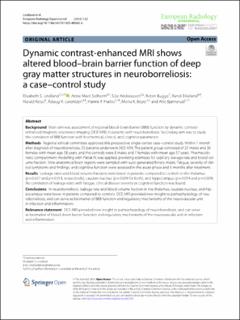| dc.contributor.author | Lindland, Elisabeth Margrete Stokke | |
| dc.contributor.author | Solheim, Anne Marit | |
| dc.contributor.author | Andreassen, Silje | |
| dc.contributor.author | Bugge, Robin Antony Birkeland | |
| dc.contributor.author | Eikeland, Randi | |
| dc.contributor.author | Reiso, Harald | |
| dc.contributor.author | Lorentzen, Åslaug Rudjord | |
| dc.contributor.author | Harbo, Hanne-Cathrin Flinstad | |
| dc.contributor.author | Beyer, Mona Kristiansen | |
| dc.contributor.author | Bjørnerud, Atle | |
| dc.date.accessioned | 2024-02-12T10:29:12Z | |
| dc.date.available | 2024-02-12T10:29:12Z | |
| dc.date.created | 2023-10-04T08:50:02Z | |
| dc.date.issued | 2023 | |
| dc.identifier.issn | 2509-9280 | |
| dc.identifier.uri | https://hdl.handle.net/11250/3116836 | |
| dc.description.abstract | Background Main aim was assessment of regional blood–brain barrier (BBB) function by dynamic contrast-enhanced magnetic resonance imaging (DCE-MRI) in patients with neuroborreliosis. Secondary aim was to study the correlation of BBB function with biochemical, clinical, and cognitive parameters. Methods Regional ethical committee approved this prospective single-center case–control study. Within 1 month after diagnosis of neuroborreliosis, 55 patients underwent DCE-MRI. The patient group consisted of 25 males and 30 females with mean age 58 years, and the controls were 8 males and 7 females with mean age 57 years. Pharmacokinetic compartment modelling with Patlak fit was applied, providing estimates for capillary leakage rate and blood volume fraction. Nine anatomical brain regions were sampled with auto-generated binary masks. Fatigue, severity of clinical symptoms and findings, and cognitive function were assessed in the acute phase and 6 months after treatment. Results Leakage rates and blood volume fractions were lower in patients compared to controls in the thalamus (p = 0.027 and p = 0.018, respectively), caudate nucleus (p = 0.009 for both), and hippocampus (p = 0.054 and p = 0.009). No correlation of leakage rates with fatigue, clinical disease severity or cognitive function was found. Conclusions In neuroborreliosis, leakage rate and blood volume fraction in the thalamus, caudate nucleus, and hippocampus were lower in patients compared to controls. DCE-MRI provided new insight to pathophysiology of neuroborreliosis, and can serve as biomarker of BBB function and regulatory mechanisms of the neurovascular unit in infection and inflammation. Relevance statement DCE-MRI provided new insight to pathophysiology of neuroborreliosis, and can serve as biomarker of blood–brain barrier function and regulatory mechanisms of the neurovascular unit in infection and inflammation. | en_US |
| dc.language.iso | eng | en_US |
| dc.publisher | Springer | en_US |
| dc.rights | Navngivelse 4.0 Internasjonal | * |
| dc.rights.uri | http://creativecommons.org/licenses/by/4.0/deed.no | * |
| dc.title | Dynamic contrast-enhanced MRI shows altered blood–brain barrier function of deep gray matter structures in neuroborreliosis: a case–control study | en_US |
| dc.type | Journal article | en_US |
| dc.type | Peer reviewed | en_US |
| dc.description.version | publishedVersion | en_US |
| dc.rights.holder | Copyright 2023 The Author(s) | en_US |
| dc.source.articlenumber | 52 | en_US |
| cristin.ispublished | true | |
| cristin.fulltext | original | |
| cristin.qualitycode | 1 | |
| dc.identifier.doi | 10.1186/s41747-023-00365-6 | |
| dc.identifier.cristin | 2181489 | |
| dc.source.journal | European Radiology Experimental | en_US |
| dc.identifier.citation | European Radiology Experimental. 2023, 7, 52. | en_US |
| dc.source.volume | 7 | en_US |

